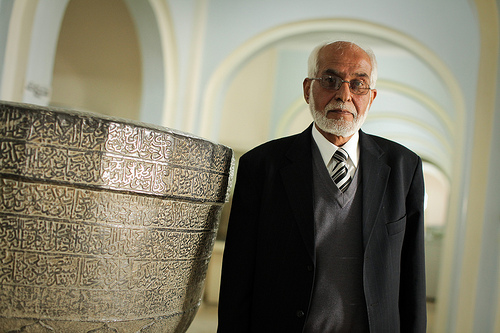March 29, 2011
by C. Brian Rose

My second full day in Kabul featured two highlights: a visit to the Kabul Archaeological Museum and a lecture at Kabul University. We were guided through the museum by the director, Omara Khan Masoudi, whom I had met in Philadelphia in 2006 at the Archaeology in Afghanistan conference. The museum has been completely restored, and there were new cases supplied by Japan and the Netherlands as well as a functioning conservation laboratory. Among the new exhibits was one on Mes Aynak, the early Buddhist site near Kabul that occupies the same area as a Chinese copper mining operation. The objects uncovered in the recent excavations are extraordinary, including some unusual painted and gilded Buddha heads. The royal palace across the street from the museum still lies in ruins, as does the building of the Institute of Archaeology, but plans for the restoration of both are underway, and as I mentioned yesterday, funds have been raised to support the construction of a new museum building within the next few years.
I wasn’t sure what to expect from my lecture at Kabul University. Although there are some similarities between Turkish and Dari, there are not enough for me to feel comfortable lecturing in the latter language. I wasn’t sure whether the students would understand my English, or what they would think of my overview of Archaeological Conservation and Historic Preservation. The room was relatively full with both male and female students, and also included Mr. Masoudi, several representatives from the American Embassy and American University, and members of the faculty of architecture of Kabul University. Not only did they understand my English; they asked some of the hardest questions I’ve received. “Support for historic preservation in Afghanistan was needed ten years ago; why had the AIA come so late? Should the Bamiyan Buddhas be reconstructed, and if not, why not? Could I play any role in training Afghan military police in cultural heritage protection, along the lines of the Troops Lectures in the U.S.? Should copper mining at Mes Aynak continue?” Some of these I was able to answer; in other cases I called on members of the audience to respond. But these were incredibly bright students—well-informed and very focused. It was yet another indication that the next generation of Afghan leaders will be articulate spokespersons for the preservation of their country’s heritage.
I leave for Ghazni by helicopter tomorrow morning, which will take us to the heart of the old Ghaznavid empire, one of the most intellectually exciting regions in the world ca. 1000 A.D.